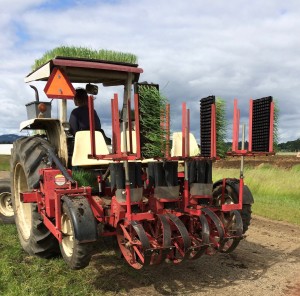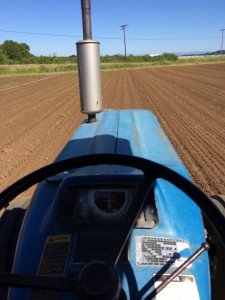Machinery (tractors and such)
So I mentioned earlier that GTF has 16 tractors (!) John Deere, Kubota, Allis Chamlers, Landini, Farm All, Ford- and quite a few more. I drove three while I was there! I used a model G Allis Chalmers to transport irrigation pipes, a Ford for transplanting with the high speed transplanter and the Landini for the lay-down transplanter.
Transplant: GTF has two main transplanter, a “high speed” transplanter and a lay-down transplanter. One might wonder why use the lay down transplanter if there is a faster one, well the leaves of some plants are too big to fit in the cups of the high speed transplanter, I wish it were different though. The lay-down is as the names suggests, the people lay down on boards behind a spinning spiked wheel. The wheel has a spike every six inches, so we would plant every other hole or every fourth hole opened on the spacing of the particular plant, Brussel sprouts, (2 ft) to swiss chard (1 ft. ) The high-speed has a spinning carousel that we would fill up and it would rotate and drop the plant into a shoot that would plant it in the ground. On the lay-down we would have to use trowels to make the holes big enough to put the plant in and then cover it up so the root ball wasn’t exposed. Thank goodness a lot of the other vegetables fit with the high speed. Another complication with transplanting on the tractor side was driving in a straight line. It was a combination of following a previous tire track and sighting the middle of the front of the tractor with a line left by field prep.
Field prep: Rodrigo (in charge of the field crew) uses a rotary harrow (rotarrow) to decompact the bed and have it ready for transplanting.
Cultivation: to keep the young plants healthy, there is a lot of cultivation and hand weeding going on. GTF has two people who just cultivate fields. They use a mix of spider gangs, danish s hooks (for bigger weeds) and basket weeders (for just emerged seeds). GTF also uses a flame thrower after planting carrots. Carrots take a while to emerge and are really slow, weeds take advantage of this. Flaming after planting carrots will kill a lot of the weeds.
Manure and Compost
GTF uses a lot of compost on their fields, as well as leaf mulch for root crops like onions and shallots. They have 10 or so ~400 ft wind rows of compost that Josh will turn. All the leaves and suckers from tomato trellising will end up in a compost pile, as well as food scraps, rabbit manure from up the road, horse stall bedding, and all the leaves that are raked up in the fall from the area. Rabbit manure is Josh’s favorite because it has a lot nitrogen. The finished product is beautiful, black, and fluffy compost.
My thoughts: I got to drive tractors! Rachel who is in charge of the M team had to do other jobs so they put me in to steer the transplanting.
whats in: Tomatoes!






